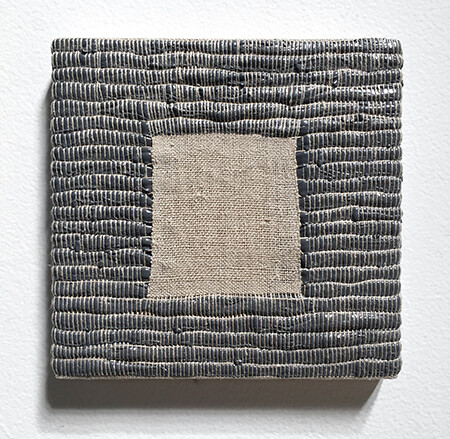Analia Saban
The Warp And Woof Of Painting
April 8–June 17, 2017
Opening: April 8, 5–8pm
Praz-Delavallade
5, rue des Haudriettes
75003 Paris
Just imagine. An enormous ball, rather like a ball of wool, blocks the entrance to the studio. It is made up of strips of hemp taken from numerous canvasses, as if the artist has dissected the epidermis of each painting. The surface’s resemblance with epithelial tissue bestows an aura of force and serenity on this sculpture and its skin-like, uniform pigmentation hints at a sort of connective tissue, a dense papillary dermis, which reveals the depth of the paint. This was the vision that awaited me when I first went to see Analia Saban. It was a totemic encounter, one that illustrated her economy of words and gesture. With this sculpture, Analia Saban enacted rules that would go on to have the force of law.
As she unravels and unties, separates, deconstructs and dismantles, Saban is on an unending quest in search of her own private grail, analysing with each new creation just what painting, her painting to be precise, should be. This questioning addresses painting, but much more besides as neither sculptures, drawings nor photos elude her investigations. She pushes back the limits and tests the capacities of each medium, whilst taking onboard the ideological repercussions that go beyond the genre and type of work in questions. Her current exhibition, The Warp and Woof of Painting, is no exception. The title is borrowed from weaving, but it is also a more metaphorical expression that conveys the idea of a complex underlying structure, one which provides the foundations of something important. In this exhibition Analia Saban presents her latest works and gives a new perspective on the weaving process in small paintings that are real gems.
The five graphite drawings titled Bouquet are at once boldly graphic as well as organically soft and intricately patterned. Each depicting a section of a revered still life—a Redon, a Monet, a Degas, a Van Gogh, and a Ruysch—reinterpreted from the original into an educational tool then again transformed using the dark line of the artist pencil to create the varied touch on paper. Refocused, enlarged and cropped capturing a slight bit of each vase from the original. The flower imagery elicits a familiar, playful response almost becoming wall paper. Somewhere amongst each composition Mabry adds in a fly that is a pollinator, placed at the center of the flower, helping to procreate and carry the seeds of the next life. Also, a symbol of memento-mori reminding us of the fragility of the flowers existence cut and arranged, as well as life itself—a vanitas moment.
Striving to show the dexterity she brings to bear on diversifying her oeuvre, she underlines the intimate proximity between the act of weaving and the way she intertwines acrylic paint into the canvas. In this truly exceptional approach, the hand’s skill combines with her artistic sensibility to create works that are made on a loom in her studio. Observing them some lovely terms come to mind—fly shuttle and shuttle box, picker and weft etc—words that have almost disappeared from our vocabulary since the advent of the industrial era. Only certain artists still posses this power to evoke and Analia Saban is undoubtedly one of them.
–René-Julien Praz
Born in 1980 in Buenos Aires, Argentina, Analia Saban currently lives and works in Los Angeles. After having received her BFA in 2001 from Loyola University, New Orleans, she continued her studies at the University of California, Los Angeles, where she obtained her MFA in 2005. Saban’s work has been the focus of important exhibitions in American and European museums like LACMA, Los Angeles (2014–15), Museum of Contemporary Art, Oslo (2014–15), Rubell Family Collection Contemporary Art Foundation, Miami (2015–16), and Georgia Museum of Art, Athens (2016) among others. This past few months, she had the chance to invest the rooms of the Blaffer Art Museum (Houston) on the occasion of her one-person exhibition. After having won the Durfee Foundation ARC Award in 2009, Analia Saban was designated the following year the Laureate of the City of Santa Monica Artist Fellowship. Saban’s work is included in numerous private and public collections: Hessel Museum of Art, Bard College, Annandale-on-Hudson; Hammer Museum, Los Angeles; MOCA, Los Angeles; Norton Museum of Art, West Palm Beach and LACMA, Los Angeles.
For all inquiries please contact Clémence Duchon: clemence [at] praz-delavallade.com or T +33 1 45 86 20 00


